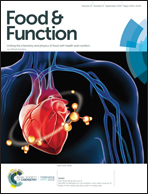Turmeronol A and turmeronol B from Curcuma longa prevent inflammatory mediator production by lipopolysaccharide-stimulated RAW264.7 macrophages, partially via reduced NF-κB signaling†
Abstract
Chronic inflammation depends on inflammatory mediators produced by activated macrophages and is the common pathological basis for various diseases. Turmeronol is a sesquiterpenoid found in the spice turmeric (Curcuma longa), which is known to have anti-inflammatory activity. To elucidate the anti-inflammatory mechanism of turmeronol, we investigated the influence of turmeronol A and turmeronol B in mouse macrophages (RAW264.7 cells) stimulated with lipopolysaccharide (LPS). Pretreatment of RAW264.7 cells with either turmeronol A or B significantly inhibited LPS-induced production of prostaglandin E2 and nitric oxide, as well as expression of mRNAs for the corresponding synthetic enzymes. In addition, the turmeronols significantly inhibited LPS-induced upregulation of interleukin-1β, interleukin-6, and tumor necrosis factor-α at the mRNA and protein levels. Both turmeronols also inhibited nuclear translocation of nuclear factor κB (NF-κB), with a similar time course to the NF-κB inhibitor pyrrolidine dithiocarbamate, but not curcumin (another NF-κB inhibitor). Thus, both turmeronols prevented activation of macrophages and inflammatory mediator production, possibly by suppressing activation of NF-κB, and therefore have potential for use in preventing chronic inflammatory diseases.



 Please wait while we load your content...
Please wait while we load your content...